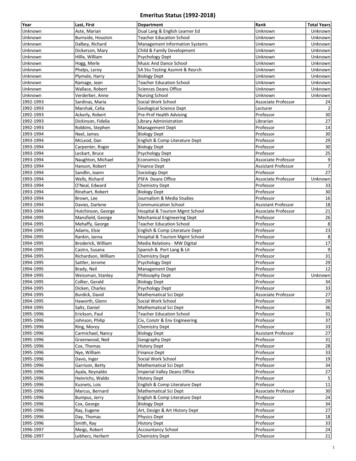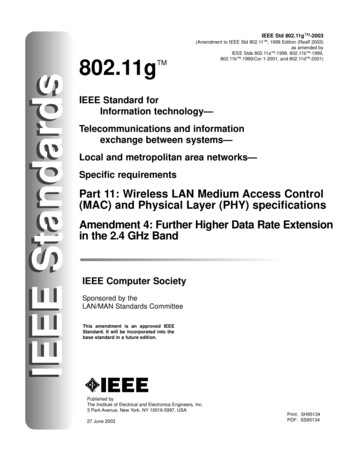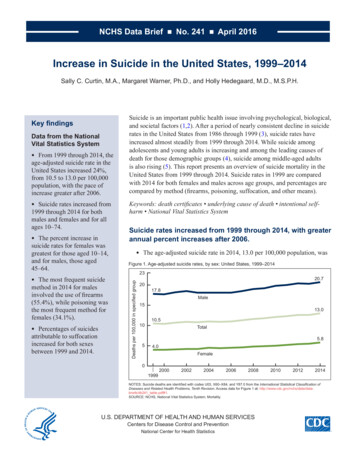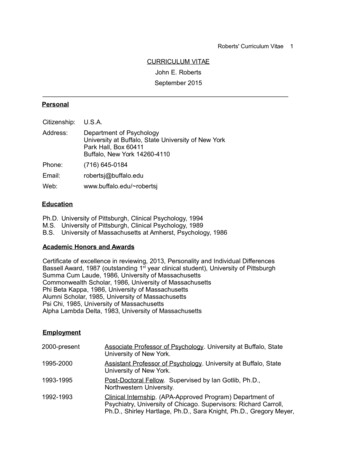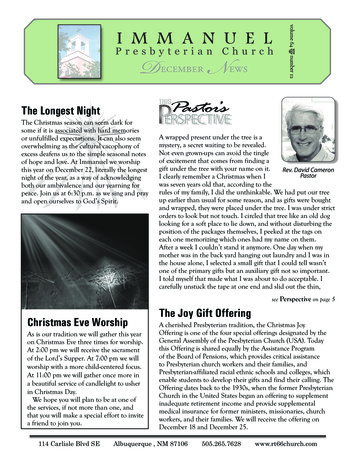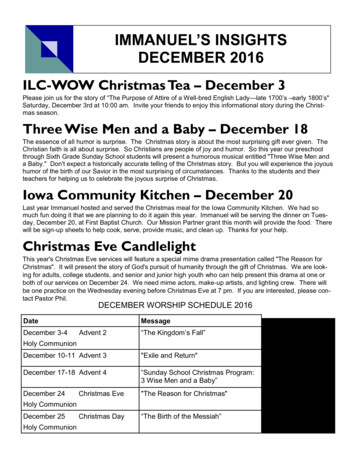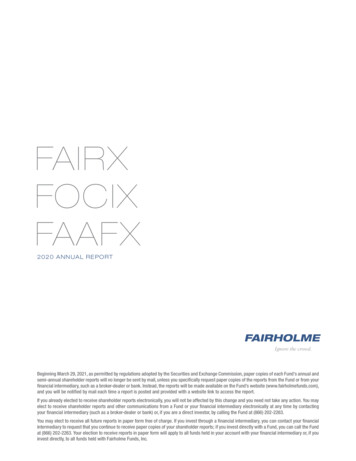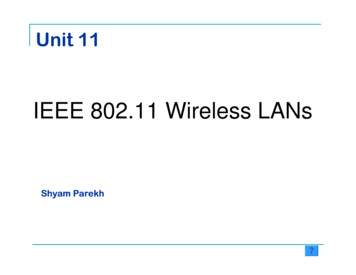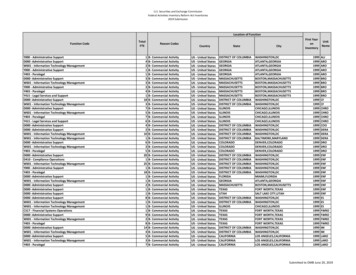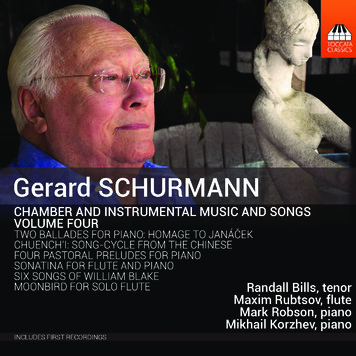
Transcription
GERARD SCHURMANN: CHAMBER MUSIC,VOLUME FOURby Paul ConwayAlthough this Toccata Classics Gerard Schurmann series has been billed hitherto as‘Chamber Music’, the definition has been expanded here to include two song-cycles.John McCabe once wrote ‘that Schurmann is an outstanding instrumental andorchestral writer is well-known – that he is equally an inspired song-writer is perhapsbecoming familiar only gradually’.1 The two contrasting cycles featured on this albumoffer text-setting of rare sensitivity and invention, substantiating McCabe’s advocacyof Schurmann as a distinguished composer for the voice.Gerard Schurmann was born on 19 January 1924 in Kertosono, Java, which wasthen part of the Dutch East Indies. During the 1950s and ’60s, he was best known forhis music for the cinema, from the Ealing classics The Long Arm (1956) and Man inThe Sky (1957) to the Disney adventure romp Dr Syn, Alias the Scarecrow (1963), TheCeremony (1963) and The Bedford Incident (1965), as well as for such fantasy titles asHorrors of the Black Museum (1959) and Konga (1961) for the American producerHerman Cohen, and The Lost Continent (1968), a Hammer Production. Otherprojects included orchestrating two Oscar-winning scores: Maurice Jarre’s Lawrenceof Arabia2 and Ernest Gold’s Exodus. Practising the strict discipline required to createvividly imaginative film scores for very specific forces to tight deadlines provedadvantageous when he subsequently began to focus on writing pieces intended forthe concert hall.The British Music Society Newsletter, No. 84 (December 1999), p. 1.Schurmann has written a substantial article on his involvement with this score at: www.mvdaily.com/articles/2009/01/lawrence.htm.122
Anyone surveying Schurmann’s current catalogue of works3 might be forgivenfor thinking he was a late developer and that the formal mastery evident in his earlyacknowledged scores sprang up fully formed. In fact, although his official canon admitsonly one score – the Bagatelles for piano (1945) – dating from his years as a fledglingcomposer, Schurmann wrote a number of works during this formative period of hiscareer which he later suppressed, including music for theatre and ballet, chamberpieces and a song-cycle setting poems about Java entitled Pacific, which enabled him toindulge his fascination with gamelan music. The first work of his to have a public airingin Britain, it was performed by the soprano Joy McArden and pianist John Wills in aconcert supported by the Society for the Promotion of New Music (SPNM).Schurmann’s concert works, though comparatively few, take in a variety of genresand demonstrate formidable technical skill. They also defy easy classification intodistinct musical traditions: though traces of his part-British heritage remain, thereare also multicultural influences, such as the subtle Magyár inflections of the choralcantata The Double Heart (1976) and, more overtly, in Chuench’i (1966), song-settingsof Chinese poetry featured in this album, and the nine Slovak Folk Songs of 1987. Sucheclecticism, far from resulting in a ragbag of conflicting styles, has helped to foster andnourish an authentic, original voice. Schurmann is his own man. He has learned to trusthis instincts. Although his harmonic language has absorbed aspects of serialism, he hasnever confined his material inside strict tone-rows, preferring instead to adapt some ofthe discipline of a restricted palette to very personal artistic ends.In addition to concertos for piano and violin, Schurmann’s orchestral pieces includeSix Studies of Francis Bacon (1968), Variants (1970) for a Classical-sized group of players,The Gardens of Exile (1989–90), a one-movement work for cello and orchestra partlyinspired by memories of semi-wild tropical gardens in Java, a Concerto for Orchestra(1996) commissioned by Lorin Maazel and the Pittsburgh Symphony Orchestra, andGaudiana (2000–1), a set of Symphonic Studies for Orchestra inspired by the workof the Catalan architect Antoni Gaudí. His substantial opera-cantata Piers Plowman3As listed on the composer’s official website: www.gerard-schurmann.com/works.htm.3
(1979–80) draws freely upon the lyricism that forms an integral part of all his works,whether featuring the voice or not.All these orchestral compositions notwithstanding, it is arguably in his songs,instrumental works and chamber music that his most personal statements reside.Schurmann has observed that ‘when I write I listen intensely, and try to respondemotionally in the most direct way possible’.4 That concentration and involvement isexperienced in its purest and most immediate form in his scores for small combinationsof instruments. His suppression of several early pieces has helped to obscure the fact thatchamber and instrumental music was at the core of his œuvre from the very beginning ofhis creative life: among the withdrawn works may be found a piano sonata, a cello sonata,a wind quintet and, most tantalisingly of all, two string quartets dating from the 1940s.The first of them was dedicated to the exiled Queen Wilhelmina of the Netherlandsand premiered in her presence in 1943 by the Hirsch String Quartet, who subsequentlyplayed it at the popular National Gallery lunchtime concerts founded by Dame MyraHess, and at the Wigmore Hall, among other venues; the second, performed by boththe Dutch Sweelinck Quartet and the Hungarian Quartet, was a short piece, composedin response to competition guidelines that required it to be a prelude to Bartók’s ThirdString Quartet (Schurmann later reworked some of its ideas in his chamber-orchestralpiece, Variants).Works that Schurmann does acknowledge include a Fantasia for cello and piano(1967),5 a Serenade for solo violin,6 a duo for violin and piano (1984),7 Ariel for solooboe (1987), two piano quartets (1986, 1998)8 and a Trio for clarinet, cello and piano(2003).9 In the 21st century, he has turned once again to the string quartet, resultingin two quintessential examples of his craft (2004 and 2012).10 Other recent works‘Gerard Schurmann in conversation with Francis Routh’, Composer, No. 92 (Winter 1987), p. 13.Recorded on Gerard Schurmann, Chamber Music, Volume 2 (Toccata Classics tocc 0220).Recorded on Gerard Schurmann, Chamber Music, Volume 3 (Toccata Classics tocc 0336).7Recorded on Gerard Schurmann, Music for Violin and Piano (Toccata Classics tocc 0133).8Recorded on tocc 0336.9Recorded on tocc 0220.10Recorded on tocc 0220.4564
include Two Violins (2015),11 written for members of the Lyris Quartet, Romancing theStrings, a nonet commissioned by the Tucson Winter Music Festival in Arizona and firstperformed on 20 March 2016, and the poignant and deeply felt piano piece, Memento,featured in a Rawsthorne Society memorial concert for John McCabe on 29 October2016, at the Royal Northern College of Music, Manchester.Chuench’i12 (1966), a cycle of seven song-settings for voice and piano of Chinesepoetry, was a landmark in Schurmann’s development as a creative artist. It was written inresponse to a commission from the American soprano Marni Nixon. Fellow composerand conductor Gerard Victory wrote that this piece ‘combines a fiercely intense andalmost intrusive passion with an unmistakably contemporary technique and highlypolished craftsmanship’.13The seven poems chosen by Schurmann represent the emotional progress of thesinger, symbolised by recollections and experiences of spring from childhood (‘Pluckingthe Rushes’), through adolescence (‘Shang Ya!’), to maturity. Unifying the cycle andpervading each poem is the ‘spirit’ or ‘atmosphere’ of spring (‘Chuench’i’), and the songswhich frame the cycle (‘New Corn’ and ‘At the End of Spring’) reflect the beginningand end of that season. The various Chinese texts by different poets were translated byDr Arthur Waley, whose adaptations also provided the texts for, among other works,Britten’s Songs from the Chinese (1957), three of Lennox Berkeley’s Five Chinese Songs(1971) and David Blake’s The Bones of Chuang Tzu (1972).14Apart from its unifying subject matter, Chuench’i gains further coherence bythematic relationships between the songs and by the central role played by the pianopart. As John McCabe observed, ‘These are not songs with piano accompaniment butrather chamber music for voice and piano’.15 Such is the concentration of the material inRecorded on tocc 0336.Pronounced ‘Chew-en-chee’.Gerard Victory, ‘Chuench’i: An Analysis of Gerard Schurmann’s Song Cycle’, The Music Review, Vol. 33, No. 3 (August 1972),p. 204.14Sadly, Dr Waley never heard Chuench’i, as he died the day before the first performance of the work.15Sleeve notes to the Nonesuch LP (h71209).1112135
these settings that McCabe has suggested that the cycle ‘might be seen as a set of veryfree variations’.16Greeting the arrival of spring, the opening song, ‘New Corn’ 1 , is permeatedby faded memories of past happiness evoked by a misty morning. The pianoaccompaniment suggests the swishing of a hand-held fan. In ‘Plucking the Rushes’2 , a boy and a girl drift idly in a boat, daydreaming. Marked Presto con petulanza,‘Shang Ya!’ 3 acts as a kind of scherzo in which vows of friendship and fidelity arefiercely affirmed. The centrepiece of the cycle, ‘Flowers and Moonlight’ 4 , brings calmand tranquillity in an idyllic description of a languorous spring evening during which awave frightens the birds away. By contrast, the toccata-like ‘Look at that Little Bay of theCh’i’ 5 is breathlessly vigorous as the singer admires a lover with eager excitement. Inthe melancholic ‘Self-Abandonment’ 6 , an awakening from a drunken sleep brings themournful discovery that spring has gone. In the final song, ‘At the End of Spring’ 7 , thepiano accompaniment again evokes the hand-held fan and returns to the material of theopening song, ushering in a stoical acceptance of the passing of time and youth, thoughnot without a parting expression of sorrowful longing. The final cluster of piano notes isdescriptive of a Chinese chandelier tinkling in a soft breeze.Schurmann’s imaginative use of harmony is entirely at the service of the text inthese graceful and intricately wrought settings. His use of the ambivalent tritone asthe main interval complements the equivocal nature of the poems. In addition, serialtechniques are deployed in such a way as to indicate tonal roots, however fleeting. Themain material of the cycle is a ten-note scale presented by the voice in the opening bar ofthe first song. Unfolding in an inexorable arch-like structure, songs I and VII are linkedthematically, whereas II and VI share a hypnotic calm and the A–E flat tritone. III andV are more recognisably tonal and articulate a similar fervour and devotion; the centralsong, IV, is the allusive and evocative heart of the work. In the moving outer settings, themesmeric, repeated quintuplet figures underline the exquisitely ephemeral nature of allthings as captured in the poetry.16Ibid.6
Chuench’i was premiered by the dedicatee, soprano Marni Nixon, withthe pianist Wilfrid Parry on 28 June 1966 at the Wigmore Hall, London. It wasrecorded by Nixon with John McCabe (piano) on Pye gsgc 14105 and Nonesuchh71209. In 1967 Schurmann wrote an orchestral version which received its firstperformance on 10 March 1968, with the Dutch soprano Ank Reinders with the RTÉSymphony Orchestra conducted by the composer at the Gaiety Theatre, Dublin. TheUK premiere took place at the Harrogate Festival on 10 August 1969, given by HazelHolt and the BBC Northern Symphony Orchestra, conducted by Erich Schmid, and thefirst US performance was given on 9 November 1972 by Marni Nixon with the SyracuseSymphony Orchestra, New York, under Frederick Prausnitz. This is the first recordingof the work with tenor voice.The Sonatina for Flute and Piano (1968) 13 was written for the Italian flautistSeverino Gazzelloni and first performed by Patricia Dunkerly (flute) and John McCabe(piano) at the Dublin International Festival of Contemporary Music in 1969. It wassubsequently programmed frequently by James Galway and many other flautists, suchas Samantha Chang, Susan Milan, Patricia Nagle and John Solum.There are five sections, played without a break. An evocative slow introduction,marked Sostenuto, provides the germinal ideas for the whole piece. It is followed by anexciting Allegro vivace of considerable contrapuntal virtuosity in which a long passagefor unaccompanied flute requires a firm command of dynamics. In the central and mostsubstantial section, the flute alone gives out a slow, brooding theme followed by fivecontrasting variations. In the first, a series of keyboard trills sustains tension. The trillspass to the flute at the start of the second variation and an intense dialogue betweenthe two instruments ensues. A fleet-footed, dance-like Allegro variation builds to aclimax. In its aftermath comes the virtuosic fourth variation, featuring the piano in highregister and microtonal pitch bends in the flute. Sustained and introspective, the fifthand final variation is sombre and heartfelt. The fourth section is a shortened version ofthe Allegro vivace and the work closes with a return, also in abbreviated form, of theopening Sostenuto.7
A powerful sense of unity is achieved in this score, not only because its five segmentsare continuous but also on account of the thematic cross-references between them.The writing for flute is idiomatic and adventurous, utilising the full compass of theinstrument and exploiting fully its dynamic and technical possibilities.The Two Ballades for piano were written in London and Los Angeles between 1981and 1983 in homage to Leoš Janáček. When visiting Czechoslovakia on a concert tourin 1978–79, it became clear to Schurmann that the music legacy of Janáček had eclipsedin popularity even that of Dvořák and Smetana. One day he was taken to see the villageof Hukvaldy, where Janáček was born and to which he returned constantly throughouthis life. In Schurmann’s words,I clearly remember the pastoral scene, like a romantic fairy tale – the ruins of a Gothiccastle, the little church with its pointed spire, the rolling wooded mountains of Beskydy,slightly veiled in the thinly trailing winter mist. The day’s journey from there to Brno,where Janáček lived and worked for most of his life, took me along that same road that heused regularly. It was a Sunday, causing the cold wintry landscapes to be totally deserted,empty, and still, except for the occasional sound of distant church bells.17The first Ballade, ‘Hukvaldy’ 14 , consists of a slow opening Sostenuto, which providesmost of the material, and the ensuing main Allegro non troppo section. Near the end,there is a brief, ghost-like quotation from part of the theme from the first movement(‘Presentiment’) of Janáček’s piano sonata 1.X.1905.The second Ballade, ‘Brno’ 15 , the longer of the two, opens very quietly with adepiction of a lonely, wintry scene, as described by Schurmann above. A bustling Allegrovivace bursts in with some force and is followed by a poignant episode marked Lento.This halting, sighing passage evokes the touching story of Janáček listening anxiously tothe breathing of his dying daughter. After a climax, the music leads back to a reworkedform of the Allegro. The main material is reflected upon in a short-lived return to theslower tempo, before a final Presto brings the piece to a stirring conclusion.17Composer’s note, prefacing the 1984 Novello score.8
A warm tribute from one directly communicative composer to another, the TwoBallades call upon pianistic technique of the highest calibre, but always engage thelistener. They were premiered on 19 September 1983 by Jeffrey Kahane at the CountyMuseum of Art, Los Angeles, and Christopher Green-Armytage gave the Ballades theirfirst UK performance at the Purcell Room, London, on 25 May 1985.Moonbird, for solo flute or recorder (1998) 8 , was written for the recorderplayer John Turner. It was first performed by the dedicatee at a recital of songs andchamber music by Schurmann and Alan Rawsthorne in the University of ManchesterDepartment of Music on 25 September 1999. Moonbird shares its title with the slowsecond movement of Schurmann’s Concerto for Orchestra, written two years earlier.Whereas the creature of the night depicted in the orchestral movement was grand andlugubrious, in this delightful solo-instrumental character study the nocturnal bird isdistinctly agile and lively in character, darting and swooping at various points in thescore and always moving with grace and elegance. Writing for a single line has the effectof liberating Schurmann’s imagination, and Moonbird is notable for its expressive rangeand narrative sweep. Although the music sounds spontaneous, the score unfolds with astrong dramatic coherence on account of Schurmann’s poetic use of a judicious selectionof recurring motifs and gestures.The Four Pastoral Preludes, for piano solo (2012), were first performed by MikhailKorzhev at the Beverley Hills Festival, California, on 7 August 2013. They were writtenafter a visit by the composer to Bellac in France and dedicated to John Poole, formerDirector of the BBC Singers, and his wife Laura, who live there. The house is builtprecipitously against a rocky cliff in a picturesque setting with small streams and a lake.In ‘Bellac’ 9 the first eight bars introduce the principal ideas developed throughoutthe rest of the piece. A secondary theme, tranquil and lyrical, appears at midpoint andis recalled at the end. In the second piece, ‘Grotto’ 10 , the occasional crash suggestsintermittent rockfalls. The generally moderate pace is punctuated by a couple of furtive,scurrying passages. ‘Rivulets’ 11 effectively juxtaposes smooth, flowing semiquaverpassages with occasional moments of stillness. The final ‘Solitude’ 12 is an eloquent and9
measured piece that begins in rich chordal progressions but is subsequently pared downto single lines in a deeply felt discourse between the hands before the final chord.Schurmann’s Six Songs of William Blake, for voice and piano, rework some of hisearlier Nine Blake Songs, written for Benjamin Britten and Peter Pears in 1956. In thesesettings the poems are unified by a common theme marking the passage of time. A newversion was commissioned by the Rawsthorne Trust in memory of the soprano TraceyChadwell, and first performed on 4 July 1997 by the soprano Alison Wells and pianistKeith Swallow as part of the Lichfield International Arts Festival. Schurmann revisedthe score further in May 2018 for the present recording.Such is its homogeneity and overarching integrity that the listener would be hardpressed to deduce that this cycle had been composed over such a long period of time.Schurmann adopts a direct and simple approach, always at the service of the text.Restraint is the keynote of these settings, as is perfectly illustrated at the start of theopening ‘Augury’ 16 as the piano begins with the same single (E flat) note with whichthe voice enters. As the piano texture fills out and the vocal line is embellished withmelismata, Schurmann laces both the vocal and piano parts with triplet figures whichform such a recurring feature throughout his entire œuvre that they must be counteda natural part of his creative personality. Following almost without a break, ‘Ah! Sunflower’ 17 is quiet, relaxed and flowing, the voice floating over the gently reassuringcontinuous semiquaver figuration in the piano. At the centre of the cycle is a slow butdynamically and harmonically far-ranging setting of ‘I Laid Me Down Upon a Bank’18 , which has the stamp of a mini-scena, with its dramatic vocal lines and tiny pianointroduction and coda. ‘Eternity’ 19 is driven by an emphatic piano ostinato anduplifted by the high tessitura of the vocal writing. In contrast, ‘The Sick Rose’ 20 creepsearthily, its dark-hued chromaticism suggesting ‘the invisible worm that flies in thenight’. Schurmann says18 that this particular song is modelled on Benjamin Britten’s ownsetting of the poem and that of all the songs in this cycle it is the closest to his originalconception of it for Britten and Pears. The set concludes with a coolly elegant setting18E-mail, 4 March 2019.10
of Blake’s poem ‘To the Evening Star’ 21 , where the steady chordal accompaniment ispoised and offers firm support to the more flexible, roving vocal line.Schurmann’s most recent revisions to the score are, for the most part, concernedwith clarifying notation and textures. Compared to the first revision, his feeling for thespeed of some of the songs has changed, so that the metronome markings of the first,fourth and sixth are slower, whereas the second is faster (there is no change in pulse inthe third and fifth). Perhaps the most substantial reconsideration applies to the fourthsong, ‘Eternity’. As well as carrying a significantly reduced metronome marking, it nowbears the simple indication, Allegretto, in contrast to its former heading of Allegro edagitato, which suggests a revised approach to the basic character of this setting as wellas to its tempo.Though not as extrovert as Chuench’i, the Blake songs are no less successful thanSchurmann’s earlier cycle in capturing the essence of the text without distracting fromit. As vital a facet of Schurmann’s art as his large-scale statements, they impart his loveof Blake as authentically as his 1968 orchestral studies reveal his passion for FrancisBacon’s paintings.Paul Conway is a freelance writer specialising in twentieth-century and contemporary British music.He has reviewed regularly for The Independent, Tempo and Musical Opinion, provided programmenotes for The Proms and the Edinburgh, Spitalfields and Three Choirs Festivals and contributedchapters to books on John McCabe and Robert Simpson.11
Hailed by Das Opernglas as a ‘vocally powerful, technicallyimpressive, dominant heroic tenor’ and by Opera News for‘his consummate mastery of Rossini’s style, range and vocalbravura’, the American tenor Randall Bills has earned praisefrom audiences and critics for performances in opera andconcert throughout the world. He has earned particularacclaim in Mozart’s Die Zauberflöte as Tamino (TheatreDortmund, Nationaltheater Mannheim, New ZealandOpera, Seattle Opera), in Don Giovanni as Ottavio (TheaterOsnabrück, Seattle Opera) and in Così fan tutte as Ferrando(English National Opera, Teatro Lirico di Cagliari), andRossini’s Armida as Geoffredo and Ubaldo (Rossini OperaFestival), Mosè in Egitto as Osiride (New York City Opera), Ilbarbiere di Siviglia as Almaviva (Oper Leipzig, Theater WielkiPoznań), La cenerentola as Ramiro (Opernhaus Chemnitz,Boston Youth Symphony, El Paso Opera), and Ricciardo e Zoraide as Agorante (Rossiniin Wildbad Festival). Other notable operas and roles he has performed include Bellini’sLa sonnambula as Elvino (Staatstheater Darmstadt), Donizetti’s La favorite as Fernand(Washington Concert Opera), Don Pasquale as Ernesto (Staatstheater Darmstadt), Verdi’sLa traviata as Alfredo (Deutsches Nationaltheater Weimar), Stravinsky’s The Rake’s Progressas Tom Rakewell (Staatstheater Braunschweig and the Oldenburgisches Staatstheater),Britten’s The Turn of the Screw as Prologue/Peter Quint (Teatro Comunale di Bologna) andStrauss’ Der Rosenkavalier as the Italian Singer (Theater Bremen, Deutsches NationaltheaterWeimar).Most recently, he debuted at the International Händel-Festspiele Karlsruhe as Jupiter inSemele, conducted by Christopher Moulds in a production from Floris Visser, as well as atGothenburg Opera as Almaviva in Rossini’s Il barbiere di Siviglia conducted by Henrik Schaeferin a production from David Radok, returned to the Rossini in Wildbad Festival as Aménophisin a new production of Moïse et Pharaon conducted by Fabrizio Maria Carminati, directedby Jochen Schönleber, and to the Theater Wielki Poznań, again as Almaviva, conducted byMassimiliano Caldi in a production by Marek Weiss-Grzesiński, where he also made his roledebut as Nemorino in L’elisir d’amore, conducted by Katarzyna Tomala in a new productionfrom Andriy Zholdak. He has appeared as a guest of a number of orchestras, including the12
Houston Symphony (Orff ’s Carmina Burana), Louisville Symphony (Berlioz’s Romeo et Juliette),Fresno Philharmonic (Beethoven’s Symphony No. 9), Naples Philharmonic (Britten’s Serenadeand Beethoven’s Ninth Symphony), and Pasadena Symphony (Mozart’s Mass in C minor andBeethoven’s Ninth), Los Angeles Master Chorale (Handel’s Messiah, Bach’s Christmas Oratorioand Mozart’s Litaniae de venerabili) and the Long Beach Mozart Festival Orchestra (Mozart’sRequiem). European orchestras with whom he has appeared include the Hamburg SymphonyFestival Orchestra, Bochum Symphony (Mozart Mass in C minor), Verona Teatro Filarmonico(Mendelssohn Elijah), Vahrer Kantorei (Rossini’s Petite messe solennelle), SinfonieorchesterWuppertal (Mendelssohn’s Lobgesang and Weber’s Freischütz-Messe), L’Orchestra Sinfonicadi Milano Giuseppe Verdi (Bach’s St John Passion), American University of Beirut Choir andChoral Society (Bach’s Magnifcat and Handel’s Utrecht Jubilate). He has also appeared in Mexicowith the Philharmonic Boca del Río (Beethoven’s Symphony No. 9). Notable conductors withwhom he has sung include Grant Gershon, Michael Guettler, Julia Jones, Jorge Mester, JayceOgren, Andrés Orozco-Estrada, Carl St Clair and Ralf Weikert.www.randallbills.com @randallbills on Twitter and InstagramThe flautist Maxim Rubtsov is one of Russia’s best musicalambassadors. Appointed Principal Flute of the RussianNational Orchestra in 2003, Rubtsov was given unprecedentedsolo opportunities with the RNO by its founding conductorMikhail Pletnev. They have included the Russian premiere ofJohn Corigliano’s Pied Piper Fantasy in 2004 under the batonof Alexander Vedernikov. Of the performance the composersaid: ‘Maxim Rubtsov is the perfect Pied Piper. He has both thecharm and excitement that a great performer must have. Withhis movie star looks and charisma, and his magnificent playingand acting of the part, the legendary piper becomes alive for allto see’. In 2014 Rubtsov re-staged the Pied Piper Fantasy withthe Omsk Symphony Orchestra, putting 40 children on stageand earning critical acclaim as soloist and production designer.Maxim Rubtsov’s US recital debut came in December 2007,with the pianist Valentina Lisitsa, presented by Friends of Chamber Music of Miami. The MiamiHerald called his playing ‘virtually faultless’ and stated that ‘he possesses a stellar technique’.13
In addition to his solo work, Maxim Rubtsov has performed hundreds of surpassinglybeautiful solo passages in symphonic music preserved in RNO recordings on the PentaToneClassics label. His solo album, Russian Romance, was re-released in 2013. A project of BlueGriffin Recording, it was engineered by Sergei Kvitko, who also accompanies Rubtsov on thepiano. Rubtsov and Kvitko were featured in concert at the National Flute Association 2011annual convention in the United States and have appeared in concert together from Connecticutto California.Born in 1977 in Bryansk, Russia, Maxim Rubtsov began to study piano at age five. At ageseven he danced with the famous Moiseyev Dance Company and only later did he begin flutelessons. At thirteen he transferred to the Gnesin Academy of Music in Moscow and subsequentlygraduated with an advanced degree in music from the Moscow State Conservatoire. He joinedthe flute section of the RNO in 1999 and was appointed Associate Principal the following year,at the time the youngest ever to hold this position in the history of the orchestra. Rubtsov hasalso performed as a flautist-dancer at the Alvin Ailey Dance Theatre with Germaul Barnes andwith the Denis Boroditsky Dance Company.His 2015 teaching residency with New World Symphony in Miami, a collaboration withMichael Tilson Thomas, featured an online master-class linking participants from the RoyalDanish Academy of Music. Previously he had been flautist-in-residence with Tilson Thomas’San Francisco Symphony Orchestra. His teaching residencies have included conservatoires,universities and music schools in Brazil, Dubai, Russia, Singapore, the United Kingdom andthe United States. He also performs in chamber ensembles and is a founding member of theRussian National Orchestra Wind Quintet, which took top honours in the Fifth Annual OsakaInternational Chamber Music Contest. Together with the RNOWQ he has explored jazz andother genre-bending compositions, including the works of Chris Brubeck for wind quintet andjazz quartet, as well as adaptations of Peter and the Wolf and Wolf Tracks for children.He has shared the stages of Europe in chamber performances with the pianists MikhailPletnev and Francesco Schlimé. In 2012 he performed with American soprano Lisa Delan atthe Napa Valley Festival del Sole, and they recorded together at Skywalker Studios in California.In 2013 he was featured flautist along with Diane Boyd Schultz (piccolo) in Chris Brubeck’smusical for children entitled Hermitage Cats Save the Day, which was premiered in the UnitedStates and Russia. In 2012 he toured Russia with the Brubeck Brothers Quartet, playing jazz andclassical compositions in tribute to the legendary Dave Brubeck.14
Mark Robson has been hailed by The Los Angeles Times as aperformer with a ‘monster technique’ and ‘an inquiring mind’;he continues to gather praise with his multi-faceted career as asoloist, chamber musician and teacher. He is equally comfortablein styles ranging from early music, which he performs on theharpsichord and organ, via the great Romantic repertoire andbeyond, to contemporary piano works demanding theatricalparticipation from the performer. He is also a highly respectedcollaborative artist with singers and instrumentalists. As afounding member of the Los Angeles-based series ‘PianoSpheres’, he presents recitals devoted to new and rarely playedmusic and has frequently performed on the ‘Jacaranda’ seriesin S
Works that Schurmann does acknowledge include a Fantasia for cello and piano (1967),5 a Serenade for solo violin,6 a duo for violin and piano (1984),7 Ariel for solo oboe (1987), two piano quartets (1986, 1998)8 and a Trio for clarinet, cello and piano (2003).9 In the 21st century, he has turned once again to the string quartet, resulting
